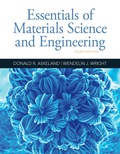
(a)
Interpretation:
The engineering stress-strain curve should be plotted and the 0.2 % offset yield strength should be calculated for the given data of magnesium.
Concept Introduction:
The maximum amount of elastic deformation which is bearable by any material is defined as yield strength.
Answer to Problem 6.40P
The yield strength for 0.2% offset is 185MPa for a given sample of magnesium.
Explanation of Solution
The tabular data providing details about the load and length difference for a given sample is as follows:
Calculate the engineering stress for the sample of with the help of below formula:
| Load (lb.) | |
| 0 | 0.00000 |
| 5000 | 0.0296 |
| 10,000 | 0.0592 |
| 15,00 | 0.0888 |
| 20,000 | 0.15 |
| 25,000 | 0.51 |
| 26,500 | 0.90 |
| 27,000 | 1.50 (fracture) |
| 26,500 | 2.10 |
| 25,000 | 2.79 (maximum load) |
In the equation (2), put value of F =5,000 N,
The below mentioned tabular data represent the value of engineering stress at different load applied at the given specimen of magnesium:
| F(N) | S (MPa) |
| 0 | 0 |
| 5000 | 44.20 |
| 10,000 | 88.40 |
| 15,00 | 132.60 |
| 20,000 | 176.80 |
| 25,000 | 221.04 |
| 26,500 | 234.30 |
| 27,000 | 238.72 |
| 26,500 | 234.30 |
| 25,000 | 221.04 |
Calculate the engineering strain for the sample of with the help of below formula:
The below mentioned tabular data represent the value of engineering stress at different load applied at the given specimen of magnesium:
| e (cm/cm) | |
| 0.00000 | 0 |
| 0.0296 | |
| 0.0592 | |
| 0.0888 | |
| 0.15 | |
| 0.51 | 0.017 |
| 0.90 | 0.030 |
| 1.50 | 0.050 |
| 2.10 | 0.070 |
| 2.79 | 0.093 |
With the use of given both spread sheets, one can tabulate the engineering stress and strain curve as follows:
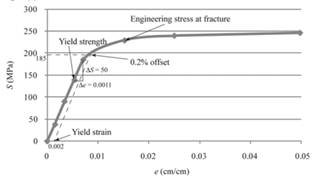
The above graph can provide the value of yield strength for 0.2% offset as 185 MPa.
Therefore, one can conclude that magnesium sample contains the yield strength for 0.2% offset as 185MPa.
(b)
Interpretation:
With the help of plotted engineering stress-strain curve, the tensile strength should be calculated.
Concept Introduction:
The tensile strength can be defined as the measurement of maximum deformation which can be bearable by any material without undergoing necking condition.
Answer to Problem 6.40P
The tensile strength is 239 MPa for a given sample of magnesium.
Explanation of Solution
With the use of a given spread sheet and applied loads, one can tabulate the engineering stress and strain curve as follows:
| F(N) | S (MPa) | e (cm/cm) | |
| 0 | 0 | 0.00000 | 0 |
| 5000 | 44.20 | 0.0296 | |
| 10,000 | 88.40 | 0.0592 | |
| 15,00 | 132.60 | 0.0888 | |
| 20,000 | 176.80 | 0.15 | |
| 25,000 | 221.04 | 0.51 | 0.017 |
| 26,500 | 234.30 | 0.90 | 0.030 |
| 27,000 | 238.72 | 1.50 | 0.050 |
| 26,500 | 234.30 | 2.10 | 0.070 |
| 25,000 | 221.04 | 2.79 | 0.093 |
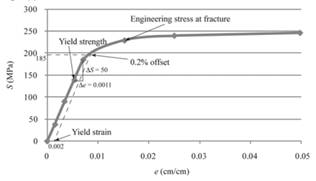
The tensile strength can be determined by use of below mentioned formula:
Therefore, one can conclude that the given sample of magnesium has the tensile strength of 239 MPa.
(c)
Interpretation:
With the help of plotted engineering stress-strain curve, the value of modulus of elasticity should be calculated.
Concept Introduction:
Modulus of elasticity is also known as coefficient of elasticity or elastic modulus and can be defined as the ratio of the stress in the given object body to the corresponding strain.
Answer to Problem 6.40P
The value of modulus of elasticity is 45,455 MPa for a given magnesium.
Explanation of Solution
With the use of a given spread sheet and applied loads, one can tabulate the engineering stress and strain curve as follows:
| F(N) | S (MPa) | e (cm/cm) | |
| 0 | 0 | 0.00000 | 0 |
| 5000 | 44.20 | 0.0296 | |
| 10,000 | 88.40 | 0.0592 | |
| 15,00 | 132.60 | 0.0888 | |
| 20,000 | 176.80 | 0.15 | |
| 25,000 | 221.04 | 0.51 | 0.017 |
| 26,500 | 234.30 | 0.90 | 0.030 |
| 27,000 | 238.72 | 1.50 | 0.050 |
| 26,500 | 234.30 | 2.10 | 0.070 |
| 25,000 | 221.04 | 2.79 | 0.093 |
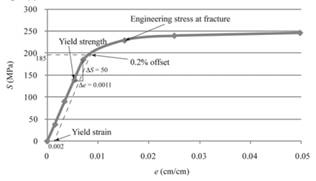
The modulus of elasticity can be determined by use of below mentioned formula:
In above equation,
Therefore, the value of modulus of elasticity for given magnesium is 45,455 MPa.
(d)
Interpretation:
With the help of plotted engineering stress-strain curve, the value of % elongation should be calculated.
Concept Introduction:
Elongation is defined as term used to determine the change in gauge length of any material when it is on static tension test.
Answer to Problem 6.40P
The value of % elongation is 8.7% for a given magnesium.
Explanation of Solution
With the use of a given spread sheet and applied loads, one can tabulate the engineering stress and strain curve as follows:
| F(N) | S (MPa) | e (cm/cm) | |
| 0 | 0 | 0.00000 | 0 |
| 5000 | 44.20 | 0.0296 | |
| 10,000 | 88.40 | 0.0592 | |
| 15,00 | 132.60 | 0.0888 | |
| 20,000 | 176.80 | 0.15 | |
| 25,000 | 221.04 | 0.51 | 0.017 |
| 26,500 | 234.30 | 0.90 | 0.030 |
| 27,000 | 238.72 | 1.50 | 0.050 |
| 26,500 | 234.30 | 2.10 | 0.070 |
| 25,000 | 221.04 | 2.79 | 0.093 |
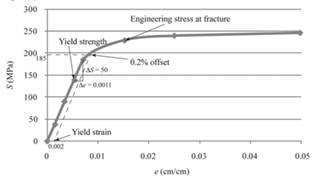
The following formula is used for determining the value of % elongation.
Therefore, the value of % elongation is 8.7% for given magnesium sample.
(e)
Interpretation:
With the help of plotted engineering stress-strain curve, the value of % reduction in area should be calculated.
Concept Introduction:
Reduction if area of any material is directly related to the reduction in cross-section area of the tensile test piece after fracture.
Answer to Problem 6.40P
The value of % reduction in area is 4.3% for given magnesium.
Explanation of Solution
With the use of given spread sheet and applied loads, one can tabulate the engineering stress and strain curve as follows:
| F(N) | S (MPa) | e (cm/cm) | |
| 0 | 0 | 0.00000 | 0 |
| 5000 | 44.20 | 0.0296 | |
| 10,000 | 88.40 | 0.0592 | |
| 15,00 | 132.60 | 0.0888 | |
| 20,000 | 176.80 | 0.15 | |
| 25,000 | 221.04 | 0.51 | 0.017 |
| 26,500 | 234.30 | 0.90 | 0.030 |
| 27,000 | 238.72 | 1.50 | 0.050 |
| 26,500 | 234.30 | 2.10 | 0.070 |
| 25,000 | 221.04 | 2.79 | 0.093 |
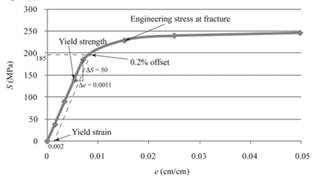
One can use the following formula for determining the value of % reduction in area.
Therefore, the given magnesium sample carries 4.3% the value of % reduction in area.
(f)
Interpretation:
With the help of plotted engineering stress-strain curve, the true stress should be determined at necking.
Concept Introduction:
True stress can be defined as the applied force or load that is divided by the cross-sectional area of specimen or object. It can be also defined as the required amount of force that tends to deformation of specimen.
Answer to Problem 6.40P
The trues stress is 251 MPa for given magnesium at necking.
Explanation of Solution
With the use of given spread sheet and applied loads, one can tabulate the engineering stress and strain curve as follows:
| F(N) | S (MPa) | e (cm/cm) | |
| 0 | 0 | 0.00000 | 0 |
| 5000 | 44.20 | 0.0296 | |
| 10,000 | 88.40 | 0.0592 | |
| 15,00 | 132.60 | 0.0888 | |
| 20,000 | 176.80 | 0.15 | |
| 25,000 | 221.04 | 0.51 | 0.017 |
| 26,500 | 234.30 | 0.90 | 0.030 |
| 27,000 | 238.72 | 1.50 | 0.050 |
| 26,500 | 234.30 | 2.10 | 0.070 |
| 25,000 | 221.04 | 2.79 | 0.093 |
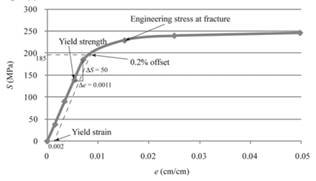
The true stress at necking can be calculated with the use of below mentioned formula:
In the above equation, putting the values to determine true stress as below.
Therefore, the given sample of magnesium has 251 MPa as a trues stress value at necking.
(g)
Interpretation:
With the help of plotted engineering stress-strain curve, the value of modulus of resilience should be determined.
Concept Introduction:
The amount of energy required to get absorbed by the material to return back to its original state is defined as resilience.
Modulus of resilience can be defined as the energy required by the material to return from its stress condition from zero to the yield stress limit.
Answer to Problem 6.40P
The value of modulus of resilience is 0.132 MPa of given magnesium.
Explanation of Solution
With the use of given spread sheet and applied loads, one can tabulate the engineering stress and strain curve as below:
| F(N) | S (MPa) | e (cm/cm) | |
| 0 | 0 | 0.00000 | 0 |
| 5000 | 44.20 | 0.0296 | |
| 10,000 | 88.40 | 0.0592 | |
| 15,00 | 132.60 | 0.0888 | |
| 20,000 | 176.80 | 0.15 | |
| 25,000 | 221.04 | 0.51 | 0.017 |
| 26,500 | 234.30 | 0.90 | 0.030 |
| 27,000 | 238.72 | 1.50 | 0.050 |
| 26,500 | 234.30 | 2.10 | 0.070 |
| 25,000 | 221.04 | 2.79 | 0.093 |
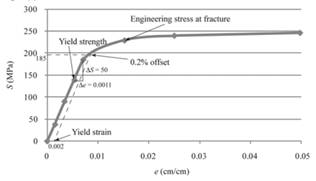
The value of yield strength and strain is 132 MPa and 0.002 respectively.
Therefore, the sample of magnesium has 0.132 MPa as the value of modulus of resilience.
Want to see more full solutions like this?
Chapter 6 Solutions
Essentials Of Materials Science And Engineering
- 250 mm 400 mm A B C E F 250 mm PROBLEM 1.52 Each of the two vertical links CF connecting the two horizontal members AD and EG has a 10 × 40-mm uniform rectangular cross section and is made of a steel with an ultimate strength in tension of 400 MPa, while each of the pins at C and F has a 20-mm diameter and are made of a steel with an ultimate strength in shear of 150 MPa. Determine the overall factor of safety for the links CF and the pins connecting them to the horizontal members. 24 kNarrow_forward50 mm 12 mm B O C OA 300 mm 450 mm E PROBLEM 1.51 Each of the steel links AB and CD is connected to a support and to member BCE by 25-mm-diameter steel pins acting in single shear. Knowing that the ultimate shearing stress is 210 MPa for the steel used in the pins and that the ultimate normal stress is 490 MPa for the steel used in the links, determine the allowable load P if an overall factor of safety of 3.0 is desired. (Note that the links are not reinforced around the pin holes.)arrow_forwardP 4.4-22 Determine the values of the node voltages V1, V2, and v3 for the circuit shown in Figure P 4.4-22. 202 ww 4ia 202 w + + ±12 V V₁ ΖΩ V2 ΖΩ V3 11 A + 하arrow_forward
- 3. A 15% magnesium chloride solution is flowing through a 5-nom sch 40 commercial steel pipe at a rate of 325,000 lbm/h. The average temperature of the magnesium chloride solution as it flows through the pipe is 10°F. Determine the convective heat transfer coefficient inside the pipe.arrow_forward3. An inifinite sheet of charge density of 3 nC/m² is located at x=-1m. An infinite line of charge density 1 nC/m is parallel to the the z-axis and intersect the y-axis at y=-1m. (a) What is the electric field vector at (0, 0, 0), assuming & = ε0? (b) What is the region in space where the field is zero?arrow_forwardI would like help to resolve the following case, thank youarrow_forward
- I need help with the following casearrow_forward2. Jojoba oil is flowing through a ¾-nom stainless steel pipe at a flow rate of 1,850 lbm/h. After the velocity profile in the pipe is fully developed, the oil enters a heater, as shown in Figure P5.7. The length of the heater section is 5 ft. The properties of the jojoba oil at the average temperature in the heater section are given in Table P5.7. Determine the convective heat transfer coefficient inside the heater section of the pipe. ¾ nom stainless steel pipe Heater section L=5ft Fig. P5.7 TABLE P5.7 Thermophysical Properties of Jojoba Oil at the Average Temperature in the Heater P (lbm/ft³) 68.671 (Btu/lbm-R) 0.30339 μ (lbm/ft-s) 0.012095 k (Btu/h-ft-°F) 0.077424arrow_forward1. Water is flowing inside of a 3-std type K copper tube at a flow rate of 1.2 kg/s. The average temperature of the water is 50°C. Cold, dry air at a temperature of 5°C and atmospheric pressure flows outside of the tube in cross flow with a velocity of 85 m/s. Determine the UA product for this tube under clean conditions.arrow_forward
- Determine the following for the beam with unknown loading, using the Shear and Bending Diagrams provided in the figures on the right: a. The maximum shear stress experienced by the beam. b. The maximum flexural stress experienced by the beam (Indicate if this is tensile or compressive flexural stress) c. The loading diagram (Indicate the magnitudes of the loading/s. The loads are acting along the plane of symmetry of the section) 20 80 20 十十 SHEAR DIAGRAM x=577.3502692 mm 20 KN 1° 5/3 KN 2° C 2° D A B CROSS SECTION Dimensions are in mm LOADING DIAGRAM ? 120 40 40 A B C D 1000mm 2000mm 1000mm -55/3 KN MB' C D BENDING DIAGRAM MB A B Σ Mcarrow_forwardFind the maximum bending stress in ksi for this beam if it is made from a W16x50 steel shape. If the steel yields at 50 ksi, will the beam support the loads shown without permanently deforming? Confirm the max moment in the beam by drawing the shear and moment diagram. 18 kip-ft 2 kip/ft 9 ftarrow_forwardQ2) by using SHI-Tomasi detector method under the constraints shown in fig. 1 below find the corner that is usful to use in video-steganography? 10.8 ...... V...... 0.7 286 720 ke Fig.1 Threshold graph. The plain test is :Hello Ahmed the key is: 3a 2x5 5b 7c 1J 55 44 2X3 [ ] 2x3arrow_forward
 MATLAB: An Introduction with ApplicationsEngineeringISBN:9781119256830Author:Amos GilatPublisher:John Wiley & Sons Inc
MATLAB: An Introduction with ApplicationsEngineeringISBN:9781119256830Author:Amos GilatPublisher:John Wiley & Sons Inc Essentials Of Materials Science And EngineeringEngineeringISBN:9781337385497Author:WRIGHT, Wendelin J.Publisher:Cengage,
Essentials Of Materials Science And EngineeringEngineeringISBN:9781337385497Author:WRIGHT, Wendelin J.Publisher:Cengage, Industrial Motor ControlEngineeringISBN:9781133691808Author:Stephen HermanPublisher:Cengage Learning
Industrial Motor ControlEngineeringISBN:9781133691808Author:Stephen HermanPublisher:Cengage Learning Basics Of Engineering EconomyEngineeringISBN:9780073376356Author:Leland Blank, Anthony TarquinPublisher:MCGRAW-HILL HIGHER EDUCATION
Basics Of Engineering EconomyEngineeringISBN:9780073376356Author:Leland Blank, Anthony TarquinPublisher:MCGRAW-HILL HIGHER EDUCATION Structural Steel Design (6th Edition)EngineeringISBN:9780134589657Author:Jack C. McCormac, Stephen F. CsernakPublisher:PEARSON
Structural Steel Design (6th Edition)EngineeringISBN:9780134589657Author:Jack C. McCormac, Stephen F. CsernakPublisher:PEARSON Fundamentals of Materials Science and Engineering...EngineeringISBN:9781119175483Author:William D. Callister Jr., David G. RethwischPublisher:WILEY
Fundamentals of Materials Science and Engineering...EngineeringISBN:9781119175483Author:William D. Callister Jr., David G. RethwischPublisher:WILEY





